小学四年级英语常用语法总结
四年级英语语法

四年级英语语法四年级英语语法主要包括动词的时态、名词的单复数、代词、形容词和副词等基本语法知识。
下面将详细介绍这些内容。
一、动词的时态(Verb Tenses)1. 一般现在时(Simple Present Tense):表示经常性的动作或习惯,一般现在时的肯定句结构为“主语 + 动词原形”,否定句为“主语 + do not/does not + 动词原形”,疑问句为“Do/Does + 主语 + 动词原形”。
例如:- He plays football every day.(他每天都踢足球。
)- They don't like ice cream.(他们不喜欢冰淇淋。
)- Does she go to school by bus?(她坐公交车去学校吗?)2. 一般过去时(Simple Past Tense):表示过去发生的动作或状态,一般过去时的肯定句结构为“主语 + 动词过去式”,否定句为“主语 + did not + 动词原形”,疑问句为“Did + 主语 + 动词原形”。
例如:- We visited the museum yesterday.(我们昨天参观了博物馆。
)- He didn't watch TV last night.(他昨晚没看电视。
)- Did you go to the park last weekend?(你上个周末去公园了吗?)3. 现在进行时(Present Continuous Tense):表示现在进行或暂时的动作,现在进行时的肯定句结构为“主语 + am/is/are + 动词-ing 形式”,否定句为“主语 +am/is/are not + 动词-ing 形式”,疑问句为“Am/Is/Are + 主语 + 动词-ing 形式”。
例如:- They are playing basketball now.(他们现在正在打篮球。
)- She isn't reading a book at the moment.(她此刻没有在看书。
小学四年级 英语语法知识总结
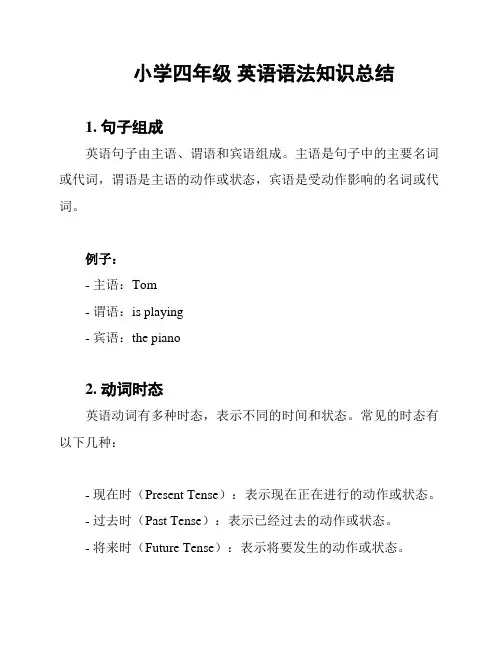
小学四年级英语语法知识总结1. 句子组成英语句子由主语、谓语和宾语组成。
主语是句子中的主要名词或代词,谓语是主语的动作或状态,宾语是受动作影响的名词或代词。
例子:- 主语:Tom- 谓语:is playing- 宾语:the piano2. 动词时态英语动词有多种时态,表示不同的时间和状态。
常见的时态有以下几种:- 现在时(Present Tense):表示现在正在进行的动作或状态。
- 过去时(Past Tense):表示已经过去的动作或状态。
- 将来时(Future Tense):表示将要发生的动作或状态。
例子:- 现在时:I play soccer every day.- 过去时:She danced at the party last night.- 将来时:We will travel to Japan next month.3. 名词单复数英语名词有单数与复数形式。
通常,名词在单数形式后加-s或-es变为复数形式。
例子:- 单数:book- 复数:books4. 代词代词用来替代名词,避免重复使用。
常见的代词包括人称代词、物主代词和指示代词。
例子:- 人称代词:I, you, he, she, it, we, they- 物主代词:mine, yours, his, hers, ours, theirs- 指示代词:this, that, these, those5. 冠词冠词用来修饰名词,分为不定冠词(a, an)和定冠词(the)。
例子:- 不定冠词:a book, an apple- 定冠词:the book, the apple6. 形容词和副词形容词用来修饰名词,描述其特征或性质;副词用来修饰动词、形容词或其他副词,描述动作的方式或程度。
例子:- 形容词:a beautiful flower- 副词:She runs fast.7. 介词介词用来表示人或事物之间的位置、关系或方式。
四年级关于英语语法知识点总结
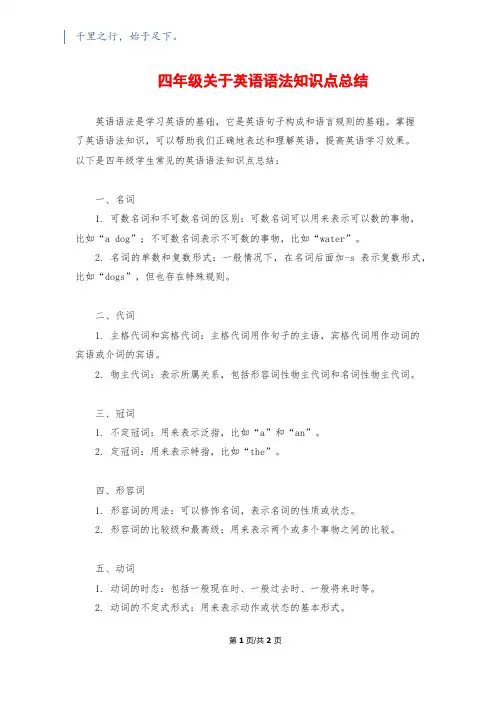
千里之行,始于足下。
四年级关于英语语法知识点总结英语语法是学习英语的基础,它是英语句子构成和语言规则的基础。
掌握了英语语法知识,可以帮助我们正确地表达和理解英语,提高英语学习效果。
以下是四年级学生常见的英语语法知识点总结:一、名词1. 可数名词和不可数名词的区别:可数名词可以用来表示可以数的事物,比如“a dog”;不可数名词表示不可数的事物,比如“water”。
2. 名词的单数和复数形式:一般情况下,在名词后面加-s表示复数形式,比如“dogs”,但也存在特殊规则。
二、代词1. 主格代词和宾格代词:主格代词用作句子的主语,宾格代词用作动词的宾语或介词的宾语。
2. 物主代词:表示所属关系,包括形容词性物主代词和名词性物主代词。
三、冠词1. 不定冠词:用来表示泛指,比如“a”和“an”。
2. 定冠词:用来表示特指,比如“the”。
四、形容词1. 形容词的用法:可以修饰名词,表示名词的性质或状态。
2. 形容词的比较级和最高级:用来表示两个或多个事物之间的比较。
五、动词1. 动词的时态:包括一般现在时、一般过去时、一般将来时等。
2. 动词的不定式形式:用来表示动作或状态的基本形式。
第1页/共2页锲而不舍,金石可镂。
3. 动词的进行时态:用来表示正在进行的动作。
六、副词1. 副词的用法:用来修饰动词、形容词或其他副词。
2. 副词的比较级和最高级:用来表示两个或多个事物之间的比较。
七、介词1. 介词的用法:用来表示时间、地点、方向、原因等关系。
八、连词1. 连词的用法:用来连接词或句子。
2. 并列连词的用法:用来连接并列的词或句子。
九、句子1. 陈述句:用来陈述一个事实或观点。
2. 疑问句:用来提出问题。
3. 肯定句和否定句的转换:在句子前面加上“not”可以将肯定句变为否定句。
4. 祈使句:用来表达请求、命令、建议等。
了解并掌握这些语法知识点,对学习英语非常重要。
要通过反复练习和实践来加深理解和掌握。
小学四年级英语常用语法总结
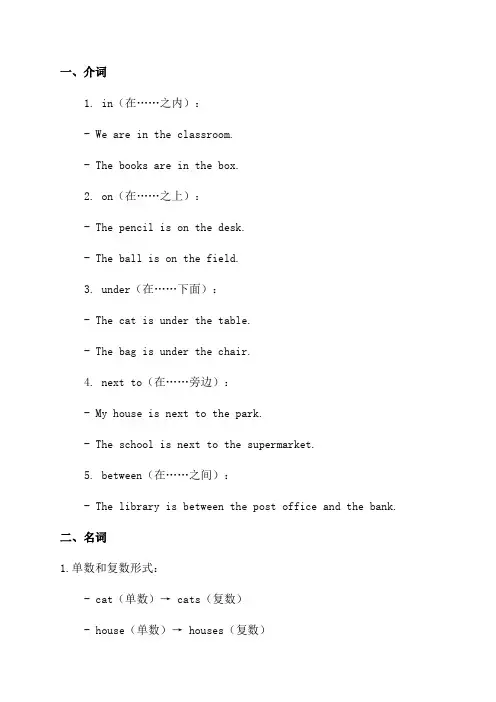
一、介词1. in(在……之内):- We are in the classroom.- The books are in the box.2. on(在……之上):- The pencil is on the desk.- The ball is on the field.3. under(在……下面):- The cat is under the table.- The bag is under the chair.4. next to(在……旁边):- My house is next to the park.- The school is next to the supermarket.5. between(在……之间):- The library is between the post office and the bank.二、名词1.单数和复数形式:- cat(单数)→ cats(复数)- house(单数)→ houses(复数)2.物主代词:- my(我的)- your(你的)- his(他的)- her(她的)- their(他们的)3.不可数名词:- water(水)- milk(牛奶)- rice(米饭)4.可数名词的限定词-a(一个)- an(一个,用于元音开头的单词)- the(这个,那个)5.形容词性物主代词:- my(我的)- your(你的)- his(他的)- her(她的)- their(他们的)三、动词1.动词的基本形式:- play(玩)- eat(吃)- run(跑)- sleep(睡觉)2.一般现在时-主语+动词原形- I play football.- She watches TV.3.一般过去时-主语+动词过去式- He played basketball yesterday.- They went to the park last week.4.现在进行时- 主语 + am/is/are + 动词-ing- I am playing basketball.- They are swimming in the pool.5.动词的否定形式- do not/does not/did not + 动词原形- I do not like bananas.- She does not play the piano.四、形容词与副词1.形容词的比较级- 形容词 + er + than- He is taller than me.- The cat is smaller than the dog.2.形容词的最高级- the + 形容词最高级 + 名词- It is the tallest building in the city.- She is the smartest student in the class.3.副词的构成- 形容词 + ly- quick(形容词)→ quickly(副词)- slow(形容词)→ slowly(副词)四、代词1.主格代词-I(我)- you(你)- he(他)- she(她)- it(它)- we(我们)- they(他们/她们)2.宾格代词- me(我)- you(你)- him(他)- her(她)- it(它)- us(我们)- them(他们/她们)3.物主代词- my(我的)- your(你的)- his(他的)- her(她的)- its(它的)- our(我们的)- their(他们的)五、句子1.陈述句-主语+谓语+宾语- I like apples.- She has a cat.2.疑问句-谓语+主语+?- Do you like bananas?- Does he have a sister?3.否定句- 主语 + do not/does not + 谓语动词- I do not play football.- She does not watch TV.六、其他常用语法点1.冠词- a/an(不定冠词)- I saw a cat in the garden.- There is an apple on the table. - the(定冠词)- The cat is gray.- The apple is tasty.2.情态动词- can(能够)- may(可能)- must(必须)- should(应该)- would like(想要)- want(想要)。
小学四年级英语语法知识总结
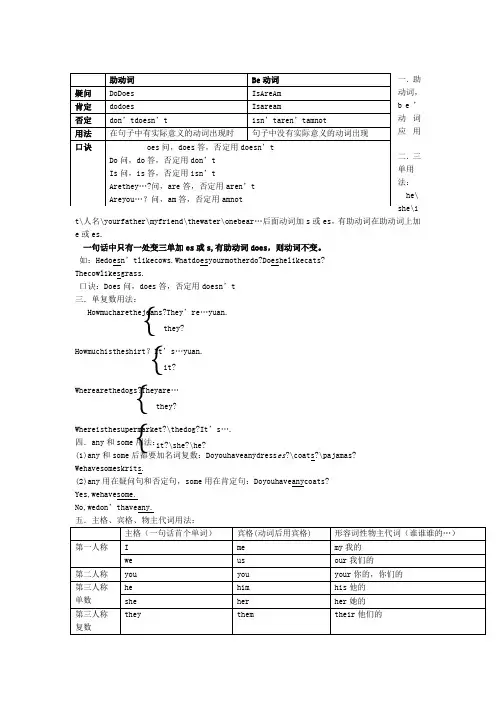
一.助动词,b e ’动词应用 二.三单用法: he\she\it\人名\yourfather\myfriend\thewater\onebear …后面动词加s 或es ,有助动词在助动词上加e 或es.一句话中只有一处变三单加es 或s,有助动词does ,则动词不变。
如:Hedoesn ’tlikecows.Whatdoesyourmotherdo?Doeshelikecats? Thecowlikesgrass.口诀:Does 问,does 答,否定用doesn ’t 三.单复数用法:Howmucharethejeans?They ’re …yuan. Howmuchistheshirt ?It ’s …yuan.Wherearethedogs?Theyare …Whereisthesupermarket?\thedog?It ’s …. 四.any 和some 用法: (1)any 和some 后都要加名词复数:Doyouhaveanydress es ?\coats?\pajamas? Wehavesomeskrits.(2)any 用在疑问句和否定句,some 用在肯定句:Doyouhaveanycoats? Yes,wehavesome. No,wedon ’thaveany.五.主格、宾格、物主代词用法:{t hey?{ it?{ t hey?{i t?\she?\he?例:主格宾格Shelikesher.Helikeshim.Helikesme.Theyknowthem.主格物主代词Shelikesherfamily.Helikeshisfamily.Ilikemyfamily.物主代词Hisfatherisa…Hermotherisa….Myfatherisa…六.W词的意思:What什么Whatdoesshedo?Where哪里Whereisthesupermarket?Who谁Whoareyou?When何时Whendoyougotoschool?Why为什么Whose谁的Whosebookisit?How怎么Howmany…?多少Howmuch…?价钱。
小学四年级英语常用语法总结
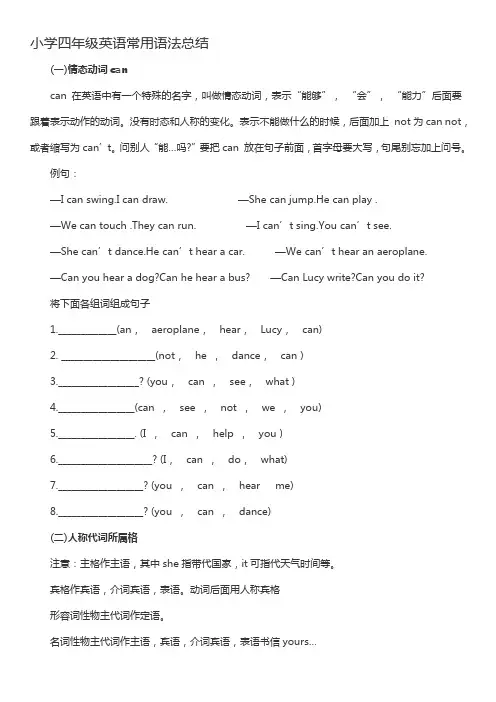
小学四年级英语常用语法总结(一)情态动词cancan 在英语中有一个特殊的名字,叫做情态动词,表示“能够”,“会”,“能力”后面要跟着表示动作的动词。
没有时态和人称的变化。
表示不能做什么的时候,后面加上not为can not,或者缩写为can’t。
问别人“能…吗?”要把can 放在句子前面,首字母要大写,句尾别忘加上问号。
例句:—I can swing.I can draw. —She can jump.He can play .—We can touch .They can run. —I can’t sing.You can’t see.—She can’t dance.He can’t hear a car. —We can’t hear an aeroplane.—Can you hear a dog?Can he hear a bus? —Can Lucy write?Can you do it?将下面各组词组成句子1._____________(an,aeroplane,hear,Lucy,can)2. _____________________(not,he ,dance,can )3.__________________? (you,can ,see,what )4._________________(can ,see ,not ,we ,you)5._________________. (I ,can ,help ,you )6._____________________? (I,can ,do,what)7.___________________? (you ,can ,hear me)8.___________________? (you ,can ,dance)(二)人称代词所属格注意:主格作主语,其中she指带代国家,it可指代天气时间等。
宾格作宾语,介词宾语,表语。
动词后面用人称宾格形容词性物主代词作定语。
小学四年级英语语法总结
小学四年级英语语法总结一、主语和谓语的一致性在英语句子中,主语和谓语需要保持一致。
主语是句子中执行动作的人、物或概念,而谓语则是描述主语动作的动词。
1. 单数主语和单数谓语的一致当句子的主语是单数形式时,谓语动词也必须使用单数形式。
例如:•My sister is a teacher.(我的姐姐是一名老师。
)•The cat sleeps on the chair.(猫在椅子上睡觉。
)2. 复数主语和复数谓语的一致当句子的主语是复数形式时,谓语动词也必须使用复数形式。
例如:•The children are playing in the park.(孩子们在公园里玩。
)•My friends like to eat pizza.(我的朋友们喜欢吃披萨。
)3. 主语为第三人称单数形式时的特殊情况当句子的主语是第三人称单数(he、she、it)时,谓语动词需要加上-s 或-es。
例如:•She likes to play soccer.(她喜欢踢足球。
)•The dog barks loudly.(狗大声叫。
)二、名词的单复数形式变化规则英语中名词的单复数形式变化有一定的规则,我们通过掌握这些规则能够正确使用名词的单复数形式。
1. 一般规则通常,英语名词的单数形式是在词尾加 -s,复数形式是在词尾加 -es。
例如:•One dog, two dogs.(一只狗,两只狗。
)•One apple, three apples.(一个苹果,三个苹果。
)2. -y 结尾的名词变复数规则当名词以辅音字母加 -y 结尾时,去掉 -y,用 -ies 来表示复数形式。
例如:•One baby, five babies.(一个婴儿,五个婴儿。
)•One strawberry, two strawberries.(一个草莓,两个草莓。
)3. 特殊变化规则有些名词的复数形式发生特殊变化。
例如:•One man, three men.(一个男人,三个男人。
[全]小学四年级英语知识点考点+语法总结
小学四年级英语知识点考点+语法总结【语法知识点】一、现在进行时用法主语在句首,am, is, are跟在后,现在分词跟着走,其他成分不可丢。
表示动作正进行,句中now时间定。
一般问句,把be提到句前去。
否定句式也简单,be后只把not填。
二、特殊疑问句用法What用途广,要问“什么”它当先。
(What’s this?)How开头来“问安”。
(How are you?)Who问“谁”。
(Who’s that man?)“谁的”Whose来承担。
(Whose eraser is this?)询问“某地”用Where。
(Where is her cat?)“哪一个”Which句首站。
(Which one?)三、动词加-s或-es方法歌诀动词三单现在式,一般词尾加-s。
s, x, ch, sh在词尾,直接加上-es。
词尾若是字母o,加上-es不用愁。
“辅音字母+y“来结尾,变y为i是正规。
-es后边紧跟随,study→studies看明白。
四、“be going to”的用法口诀be going to, 表打算,准备、计划将干。
表可能,有必然,通过现象来推断。
使用它,要注意,疑问形式be提前。
否定句,更简单,not放在be后边。
to之后,动原形,be的形式看人称。
下列词,要注意,come go和离去(leave) 进行时,表将来,牢牢记住莫忘记。
五、祈使句用法祈使句,祈使句,请求、命令或建议。
主语是you常省去,动词原形开头记。
否定形式要注意,句首要把Don’t加。
要讲客气用please,句首句末没关系。
【基础知识】一、复数形式Sheep = sheep (绵羊) hen= hens(母鸡) Goat= goats(山羊) cow= cows(奶牛) horse= horses(马) foot=feet(脚) tooth= teeth(牙齿)二、可数名词变复数的规则:1、一般情况下,在单数名词词尾加“s”.如:Cat= cats dog=dogs book= books ruler= rulers2、在以s,ss , x , sh , ch 结尾的名词后面加“es”,如:Box= boxes peach=peaches bus= busesclass= classes3、在以o结尾的单词后面加“es”,如:Tomato= tomatoes potato=potatoes4、以元音字母加y结尾的名词,直接加“s”如:Boy=boys toy=toys day= days以辅音字母加y结尾的名词,去掉y后加“ies”,如:Baby= babies lady= ladies butterfly =butterflies5、以f,fe结尾的名词,去掉f或fe后加“ves”,如:shelf=shelves leaf=leaves knife= knives三、I like…后面要加可数名词的复数形式或者不可数名词,如:I like apples . 我喜欢苹果。
四年级英语语法总结
四年级英语语法总结英语语法是英语学习的基础,对于四年级的学生来说,掌握必要的语法知识点至关重要。
本文将对四年级英语语法进行总结,帮助学生们巩固所学知识,提升英语水平。
一、时态1.一般现在时:描述经常发生的动作或状态。
例句:I go to school every day.2.一般过去时:描述已经发生的动作或状态。
例句:He visited his grandparents last weekend.3.一般将来时:描述将要发生的动作或状态。
例句:We will have a sports meeting next week.二、名词1.可数名词:有单数和复数形式,可以计数。
例词:apple, book, student2.不可数名词:没有单数和复数形式,不可以计数。
例词:water, air, music三、冠词1.不定冠词:a和an,用于可数名词单数形式前。
例句:a book, an apple2.定冠词:the,表示特指。
例句:the red book四、代词1.人称代词:代替人称名词。
例词:I, you, he, she, it, we, you, they2.物主代词:表示所有关系。
例词:my, your, his, her, its, our, your, their3.反身代词:表示动作的反射。
例词:myself, yourself, himself, herself, itself, ourselves, yourselves, themselves五、介词表示时间、地点、方向等关系。
例词:in, on, under, above, behind, in front of, near, between, among六、连词连接句子、短语或单词。
例词:and, but, or, because, so, if, although七、形容词和副词1.形容词:修饰名词。
例词:big, small, tall, short, happy, sad2.副词:修饰动词、形容词或其他副词。
小学四年级英语语法总结
一、名词复数规则1. 一般情况;直接加-s;如:book-books; bag-bags; cat-cats2. 以s. x. sh. ch结尾;加-es;如:bus-buses; box-boxes; watch-watches手表3. 以“辅音字母+y”结尾;变y为i; 再加-es;如:family-families; strawberry-strawberries 但boy-boys4. 以“f或fe”结尾;变f或fe为v; 再加-es;如:knife-knives leaf-leaves5. 以o结尾有生命的加es 无生命的加s;如:potato-potatoes tomatoes photo-photos piano-pianos不规则名词的复数:man-men; woman-women; policeman-policemen; policewoman-policewomen; child-children; foot-feet; tooth-teeth; fish-fish; people-people; Chinese-Chinese; goose-geese不可数名词没有复数形式: paper; juice; water; milk; rice; tea在具体句子中我们应该把不可数名词当成单数看待二、一般现在时一般现在时的功能1.表示事物或人物的特征、状态..如:The sky is blue.天空是蓝色的..2.表示经常性或习惯性的动作..如:I get up at six every day.我每天六点起床..3.表示客观现实..如:The earth goes around the sun.地球绕着太阳转..一般现在时的标志词:often; usually; sometimes; every等一般现在时的构成主语+动词原形..如: We study English. 我们学习英语..当主语为第三人称单数he; she; it;my father等时主语三单+动词的三单形式要在动词后加"-s"或"-es"如:Mary likes Chinese.玛丽喜欢汉语..一般现在时的变化否定句:主语+ don't doesn't +动词原形+其它.. 如: I don't like bread. He doesn't like bread; too.一般疑问句:Do Does +主语+动词原形+其它.. 如: Do you go to school by bike Yes; I do. / No; I don't.当主语为第三人称单数时;要用does构成一般疑问句.. 如: Does she go to school by bike Yes; she does. / No; she doesn't.特殊疑问句:特殊疑问词+一般疑问句..如:How dou you go to school How does your father go to work动词的第三人称单数的变化规则1.一般情况下;直接加-s;如:cook-cooks; make-makes2.以s. x. sh. ch. o结尾;加-es;如: wash-washes; watch-watches; go-goes3.以“辅音字母+y”结尾;变y为i; 再加-es;如:study-studies 但play-plays不规则变化have-has三、现在进行时1.现在进行时表示现在正在进行或发生的动作..2.现在进行时的肯定句基本结构:主语+be+ 动词ing. 如: I am eating.现在进行时的否定句基本结构:主语+be not + 动词ing. 如: I am not eating.现在进行时的一般疑问句基本结构: be动词 +主语 +动词ing. 如: Are you eating现在进行时的特殊疑问句基本结构:特殊疑问词+ be +主语+动词ing如:What are you eating动词的ing形式动词的现在分词的变化规则1 一般情况下直接在动词后面加ingread--reading sleep---sleeping study---studying clean--cleaning play---playing2 以不发音的字母e结尾的动词;去掉字母e;再加ingcome---coming make---making ride---riding have---having take---takingwrite---writing dance---dancing3 以重读闭音节重读闭音节即两个辅音中间夹一个元音并且重读的音节结尾;呈现“辅;元;辅”结构的动词;双写末尾的辅音字母;再加ingstop--stopping停sit--sitting坐run--running跑begin—beginning开始cut--cutting切get--getting得到swim--swimming游dig--digging挖四、一般将来时一、概念:表示将要发生的动作以及打算或者准备做某事..句中一般有以下时间状语:tomorrow; this weekeng; next dayweek; month; year…;等..二、基本结构:①主 + be going to + 动词原形;②主 +will+ 动词原形.I am going to play football tomorrow明天. = I will play football tomorrow.三、否定句:在be动词am; is; are后加not;主 + be not going to + 动词原形..例如:I’m going to have a picnic this afternoon.→ I’m not going to have a picnic this afternoon.四、一般疑问句:把be提到句首;some改为any; 第一二人称互换..Be + 主+ going to +动词原形例如:We are going to swim this weekend. → Are you going to swim this weekend五、一般过去时1.一般过去时表示过去某个时间发生的动作或存在的状态;常和表示过去的时间状语连用..一般过去时也表示过去经常或反复发生的动作.. 2.一般过去时Be动词的变化:3.⑴ am 和is在一般过去时中变为was..was not=wasn’t4.⑵ are在一般过去时中变为were..were not=weren’t5.⑶带有was或were的句子;其否定、疑问的变化和is; am; are一样;即否定句在was或were后加not;一般疑问句把was或were调到句首.. 3.没有be动词的一般过去时肯定句:主语+动词过去式如: Jim went home yesterday. 否定句:主语+didn’t +动词原形如:Jim didn’t go home yesterday.一般疑问句: Did+主语+动词原形如:Did Jim go home yesterday特殊疑问句:⑴疑问词+did+主语+动词原形如: What did Jim do yesterday⑵疑问词当主语时:疑问词+动词过去式如:Who went to home yesterday动词过去式变化规则:1.一般在动词末尾加-ed;如:clean-cleaned; cook-cooked2.以不发音的e结尾的在词尾加d;如:like-liked live-lived3.末尾有一个元音字母和一个辅音字母的重读闭音节;双写末尾的辅音字母;加-ed;如:stop-stopped4.以“辅音字母+y”结尾的;变y为i; 再加-ed;如:study-studied 但play-played5.不规则动词过去式:am; is-was; are-were; do-did; see-saw; get-got; go-went; come-came; have-had; eat-ate; take-took; sing-sang; put-put; make-made; read-read; write-wrote; draw-drew; fly-flew; ; swim-swam六、比较级1、比较级在句子中的运用:两个事物或人的比较用比较级;比较级后面一般带有单词than..一般句式的构成:A + is / are+ 形容词比较级+ than + BA 是主格B 是宾格如: She is taller than me.2.形容词加er的规则:⑴一般在词尾加er 如:small--smaller clean--cleaner ;⑵以字母e 结尾;加r 如:fine--finer nice--nicer;⑶闭音节单音节词如末尾只有一个辅音字母;须先双写这个辅音字母;再加-er 如:big--bigger hot--hotter ;⑷以“辅音字母+y”结尾;先把y变i;再加er 如:heavy--haevier easy--easier..3.不规则形容词比较级:4. good-better;5.七、There be 句型与have; has的区别1、There be 句型表示:在某地有某物或人2、在there be 句型中;主语是单数;be 动词用is ; 主语是复数;be 动词用are ; 如有几件物品;be 动词根据最接近be 动词的那个名词决定..3、there be 句型的否定句在be 动词后加not ; 一般疑问句把be 动词调到句首..4、there be句型与have has 的区别:there be 表示在某地有某物或人;have has 表示某人拥有某物..5、some 和any 在there be 句型中的运用:some 用于肯定句; any 用于否定句或疑问句..6、针对数量提问的特殊疑问句的基本结构是:How many + 名词复数 + are there + 地点短语八、人称代词和物主代词。
- 1、下载文档前请自行甄别文档内容的完整性,平台不提供额外的编辑、内容补充、找答案等附加服务。
- 2、"仅部分预览"的文档,不可在线预览部分如存在完整性等问题,可反馈申请退款(可完整预览的文档不适用该条件!)。
- 3、如文档侵犯您的权益,请联系客服反馈,我们会尽快为您处理(人工客服工作时间:9:00-18:30)。
(一)情态动词cancan 在英语中有一个特殊的名字,叫做情态动词,表示“能够”,“会”,“能力”后面要跟着表示动作的动词。
没有时态和人称的变化。
表示不能做什么的时候,后面加上not为can not,或者缩写为can’t。
问别人“能…吗?”要把can 放在句子前面,首字母要大写,句尾别忘加上问号。
例句:—I can swing.I can draw.—She can jump.He can play .—We can touch .They can run.—I can’t sing.You can’t see.—She can’t dance.He can’t hear a car.—We can’t hear an aeroplane.—Can you hear a dog?Can he hear a bus?—Can Lucy write?Can you do it?将下面各组词组成句子1._____________.(an,aeroplane,hear,Lucy,can)2. _____________________.(not,he ,dance,can )3.__________________? (you,can ,see,what )4._________________.(can ,see ,not ,we ,you)5._________________. (I ,can ,help ,you )6._____________________? (I,can ,do,what)7.___________________? (you ,can ,hear me)8.___________________? (you ,can ,dance)(二)人称代词所属格注意:主格作主语,其中she指带代国家,it可指代天气时间等。
宾格作宾语,介词宾语,表语。
动词后面用人称宾格形容词性物主代词作定语。
名词性物主代词作主语,宾语,介词宾语,表语书信yours…表示---- 的,这样的词我们也学习很多了,你能想出来吗?记住这个小口诀就很容易了:我的my ,你的your,他的his、她的her. //它的是its; 我们的our; 你们的是your他们(它们,她们)的是their//这些人称代词形式称为人称代词所属格,也叫形容词性物主代词。
通常用在名词前面表示所属关系。
另外,表示某人的还可以用名词或人名+ ’s 来表示。
如:my kite;your book;his pen;her coat;its tail;our class;their teachers;my brother’s;book;the cat’s ears;Mary’s mother一.写出下列人称代词的所属格形式I________you_________he______________She_________ it____________we_____________You_________they_________二.用合适的人称代词填空(1) This is Ben. This is _______bicycle.(2) I am Kitty.______ bag is blue(3) She’s Alice.That’s _____ umbrella.(4) You are Mr Li.______ car is black.(5) Is this ______ hat?Yes,it’s my hat.(6) That’s my mother.That’s _____ coat.(7) Where’s ______ scarf?Here you are.(8) He’s Mr Wang._____ gloves are new.三.翻译下列词组1. 你的名字_____________2.我们班___________3. 他的小弟弟____________4.我祖母___________5. 它的尾巴______________6.我的鞋____________7. 她的围巾________________8.我的衬衫_________9. 他们的老师______________10.玛丽的雨伞_________四.用下列单词组句1.___________________________ (my ,is,name ,Tom)2.____________________________ (is,miss ,Gao,,our,friend)3.____________________________ (is what ,your number ,telephone)4.____________________________? (mother ,your ,a teacher ,is)5.____________________________? (who’s ,cap ,it ,is)答案:一. I(my)you (your)he(his)she(her)it(its)We (our)you (your)they (their)三. 1.your name 2.our class 3. his little brother 4.my grandmother5.its tail6.my shoes7.her scarf8.my shirt9.their teacher10. Mary’s umbrella四. 1.My name is Tom. 2.Miss Gao is our friend 3.What’s your telephone number? 4.Is your mother a teacher? 5.Who’s cap is it?(三)介词、连词和感叹词1.介词:介词是一种虚词,不能单独使用,必须在介词后面加上个名词或代词使用,作句子成份。
介词后面的名词(或相当于名词的其它词)叫做介词的宾语。
介词和介词宾语合称为介词短语。
介词短语在句中可作壮语、定语或表语。
介词如: in 在…里面on在…上面under在…下面等。
in the classroom in the tree in the hallon the road on the desk on the floorunder the table under the bed under the chair2.连词:连词是用来连接词与词、短语与短语、句子与句子等的词叫连词。
连词是一种虚词,在句子中不能单独作句子成分。
连词分两类:一类叫等立连词,另一类叫从属连词。
(1). 等立连词是用来连接同等的词、词组和分句的。
等立连词有许多我们现在只学到了and和but,其他的以后学到再介绍。
如:A and B ; blue and white ;an apple and a banana;a car and a bus;Lucy and Ben ; Ben and Kitty ;This is a lorry and that’s a drill.I like dolls and you like robots.(2). 从属连词是用来引起从句的、从属连词又分为1) 引起名词性从句的连接词,如:if ,that 等。
2)引起壮语从句的连接词,如:when ,after ,before等。
以后会逐渐学到再介绍。
3.感叹词: 表示说话人的某种感情(惊讶,高兴,痛苦等)的词叫感叹词。
感叹词后常用感叹号。
常用的感叹词有:oh(表示惊奇或痛苦),ah(表示惊奇或满意),hello(常被用来打招呼相当于汉语的“喂!”),well(表示惊讶,无奈)如:Hello.Are you Mary?练习:翻译下列词组1.在桌子上面2.在树下面3.在椅子上面4.在盒子里面5.在黑板上6.在书里7.在脸上8.在公共汽车上9.一只猫和一只狗.10.又小又胖答案:1. on the desk 2. under the tree 3. on the chair 4. in the box 5. on the blackboard 6. in the book7. on the face8. on the bus 9. a cat and a dog 10. small and fat(四) 单数句和复数句:口诀:单数句子变,变化规则要记住。
名词代词要变化,am,is要变are。
this,that变成啥,these,those来替它。
he,she,it要变啥,全部变they 不用怕。
I要变we莫落下,名词后面把s/es加。
名前冠词去掉它,其余成分原样加。
具体注意下面的六要素:1.单数主格人称代词要变成相应的复数主格人称代词,即I→we; you→you; she,he,it→they。
如:She is a girl.→They are girls.2. am,is要变为are。
如:I‘m a student. →We are students.3.不定冠词a,an要去掉。
如:He is a boy. →They are boys.4.普通单数名词要变为复数形式。
如:It is a cat. →They are cats.5.指示代词this,that要变为these,those。
如:This is a book.→These are books.6. man,woman作定语修饰可数名词时,要在”数”上与被修饰名词保持一致。
但其他名词修饰名词表示”性质”时,不作变化。
如:He is a man doctor.→They are men doctors.This is an apple tree.→They are apple tre es.单复数相互转换,每空一词(含缩写)。
1. The woman is a nurse.(改为复数句)The _________ _________ _________.2. There are some old cars.(改为单数句)There _______ _______ old _______.3. He has a new book.(改为复数句)______ ______ new _______.4. Are these your chicks ?(改为单数句)_____ _______ your _______?5. Is there a sheep in the playground?(改为复数句) ____ there ____ ____ in the playground?(五)一般疑问句及特殊疑问句句子基本是:简单陈述句,由简单陈述句转变成肯定句,否定句,疑问句。
